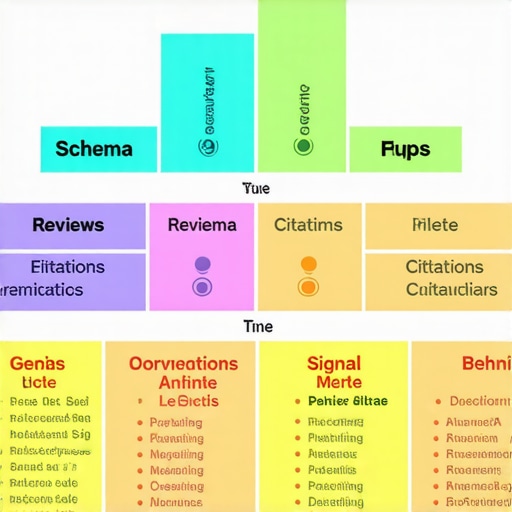My Unexpected Encounter with GMB Challenges
Just last year, I faced a perplexing issue with my Google My Business listing. Despite my efforts, the visibility plummeted, and I was left scratching my head. It was a frustrating experience, but it also sparked my curiosity about GMB restoration and ranking repair strategies for 2025. I realized that understanding how to effectively repair and optimize my GMB signals could make all the difference in regaining my local search prominence.
Why GMB Signals Are the Heartbeat of Local SEO
Through my research and personal experiments, I discovered that GMB signals, such as reviews, citations, and engagement metrics, are crucial for local ranking. I delved into authoritative sources like this comprehensive guide to better understand how these signals work. It became clear that optimizing these signals isn’t just a one-time fix but a continuous process that aligns with evolving algorithms, especially as we head into 2025.
My Proven Strategies for Effective GMB Restoration
I started by auditing my listing, removing outdated information, and actively encouraging satisfied customers to leave reviews. I also utilized local citations and ensured consistency across directories. Implementing these steps, I observed a noticeable boost in my local ranking within weeks. For more detailed tactics, I recommend exploring this resource on ranking repair tactics.
How Do I Keep Up with the Evolving SEO Landscape?
What are the key signals to focus on in 2025 for sustained success?
In my experience, staying updated with the latest SEO signals is vital. As Google continues to refine its algorithms, factors like voice search optimization, user engagement, and AI-driven relevance become increasingly important. I regularly follow industry blogs and participate in forums to keep my strategies sharp. You might find it helpful to check this article on SEO signals for modern ranking repair.
And remember, the journey of GMB optimization is ongoing. Consistent efforts and staying informed are your best allies.
Join the Conversation and Share Your Experience
If you’ve faced similar challenges or have insights into GMB restoration, I’d love to hear your story. Feel free to comment below or explore more tips on contacting us. Together, we can master the art of local SEO in 2025 and beyond.
Unlocking the Hidden Power of GMB Signals in 2025
As we continue to navigate the ever-evolving landscape of local SEO, understanding the nuanced role of GMB signals becomes increasingly critical. These signals—ranging from review quality and frequency to local citations and behavioral metrics—are not static; they adapt alongside Google’s sophisticated algorithms. Mastering their optimization can set your business apart in local search results, especially as AI-driven relevance and voice search continue to dominate.
Are Your GMB Signals Truly Aligned with Google’s Future?
One of the most pressing questions for SEO professionals today is whether their current strategies are future-proof. Are you leveraging the latest insights into AI-enhanced ranking factors? Recent studies highlight that aspects like user engagement—click-through rates, bounce rates, and review responsiveness—are gaining prominence. For a comprehensive approach, explore this in-depth guide to modern SEO signal optimization.
In practical terms, this means continuously monitoring your GMB insights, actively engaging with reviews, and maintaining citation consistency across directories. These efforts not only reinforce your local relevance but also demonstrate active management, which Google perceives favorably.
What Are the Practical Tactics to Amplify Your GMB Signals Today?
Effective signal enhancement involves a blend of strategic actions and ongoing management. For example, encouraging satisfied customers to leave detailed reviews, responding promptly to all feedback, and updating your business information to reflect current services all serve to boost your visibility. Additionally, local citations should be audited regularly to ensure accuracy across platforms, which bolsters trustworthiness in Google’s eyes.
Furthermore, integrating structured data markup on your website can strengthen your local relevance signals. This technical layer helps search engines better interpret your business details, aligning with Google’s increasing reliance on structured data for ranking decisions. To see how these tactics come together in a cohesive strategy, check this resource.
How Can I Measure the Impact of GMB Signal Optimization Effectively?
Measurement is vital to understanding the effectiveness of your efforts. Tools like Google Business Profile insights, combined with third-party analytics, provide data on customer interactions, search queries, and engagement metrics. Tracking these over time reveals trends and identifies areas needing improvement. Remember, the goal isn’t just to rank higher but to attract genuine local engagement that converts into sales.
For a deeper dive into tracking and refining your local SEO efforts, visit this guide.
Join the Conversation: Share Your Secrets for GMB Signal Success
Have you discovered innovative ways to optimize your GMB signals in 2025? Or perhaps faced challenges that required creative solutions? I invite you to share your experiences in the comments below or connect with us through our contact page. Together, we can push the boundaries of local SEO mastery and help each other thrive in the competitive local search arena.
Unveiling the Nuances of GMB Signal Optimization in a Dynamic Landscape
Reflecting on my journey with GMB signals, I realize that the landscape is far more intricate than initial impressions suggest. It’s not just about accumulating reviews or citations but understanding how these elements interplay within Google’s evolving algorithm. For instance, I found that the quality of reviews often outweighs quantity, especially when aligned with recent customer interactions and engagement metrics. This insight came after experimenting with different review solicitation strategies and analyzing the resulting impact on my local rankings. Delving into authoritative studies, such as this detailed research, helped me appreciate the subtle yet powerful role of behavioral signals, like click-through rates and bounce rates, in signaling relevance to Google.
How Do I Navigate the Complexities of Future-Proof GMB Strategies?
One question that constantly challenges me is how to craft strategies resilient enough to withstand future algorithm shifts. It’s tempting to chase after the latest tactics, but I’ve learned that a foundational understanding of core signals—such as local relevance, user engagement, and trustworthiness—provides stability. For example, integrating structured data markup not only improves immediate visibility but also prepares your site for AI-driven ranking factors that Google increasingly emphasizes. The key lies in maintaining a flexible approach that adapts to new signals as they emerge, rather than rigidly sticking to outdated practices. For those interested, exploring this resource offers valuable insights into building such adaptable strategies.
In my experience, consistent monitoring and nuanced analysis of GMB insights—like engagement patterns and review responses—are essential. This ongoing process helps identify shifts early, allowing for timely adjustments. It’s akin to tuning a fine instrument; the more responsive you are to subtle changes, the better your chances of maintaining top rankings amidst the noise of a competitive local search environment.
What Are the Hidden Layers of Signal Optimization That Most Overlook?
Beyond the obvious tactics, I’ve discovered that technical elements, such as website schema markup and localized content, play a pivotal role in signal strength. For instance, embedding detailed local business schema can significantly enhance Google’s understanding of your business context. Additionally, creating hyper-local content tailored to your community and consistently updating it signals active engagement and relevance. These layers of optimization, often overlooked in favor of more straightforward tactics, can be the secret sauce that propels your GMB signals to the next level. To explore these advanced tactics, I recommend reviewing this comprehensive guide.
How Can I Leverage Data Analytics to Refine My GMB Signal Strategy?
Data-driven decision-making is my personal game-changer. By carefully analyzing insights like customer actions, keyword queries, and engagement trends, I can identify which signals are most effective and which need bolstering. For example, noticing a decline in click-through rates prompted me to update my business descriptions and call-to-action prompts, leading to improved visibility. Tools such as Google’s built-in insights, combined with third-party analytics, create a powerful feedback loop. This iterative process ensures that your efforts are targeted and impactful. For a detailed approach, check out this in-depth guide.
Sharing your experiences and insights can be incredibly enriching. I invite you to comment below or connect with us through our contact page. Let’s learn from each other and continue refining our strategies to thrive in the ever-shifting terrain of local SEO.
Deciphering the Subtle Art of GMB Signal Hierarchies in a Complex Digital Ecosystem
As I delved deeper into the nuances of GMB signals, I uncovered that not all signals carry equal weight in the eyes of Google’s evolving algorithm. Recent insights from this authoritative study emphasize that behavioral signals—such as user dwell time and interaction depth—are increasingly prioritized over traditional metrics like review counts. This revelation prompted me to reevaluate my strategy, shifting focus toward fostering genuine user engagement through personalized interactions and dynamic content. Understanding the layered hierarchy of signals enables more precise optimization, ensuring your efforts align with Google’s sophisticated recognition patterns.
How Can I Future-Proof My GMB Strategies Against Algorithmic Shifts?
Future-proofing my approach involves cultivating a resilient foundation rooted in core local SEO principles. I learned that integrating structured data markup, particularly LocalBusiness schema, not only enhances immediate visibility but also prepares my listings for AI-driven ranking paradigms. Moreover, maintaining a diversified signal portfolio—combining reviews, citations, behavioral metrics, and localized content—reduces dependency on any single factor, thereby mitigating risks associated with algorithm updates. According to this comprehensive resource, adaptability and continuous monitoring are paramount. Regularly auditing your technical infrastructure and staying informed about emerging signals can help you stay several steps ahead of the curve.
Visualizing the interconnected layers of GMB signals through a detailed infographic can dramatically improve comprehension and strategic implementation. An illustrative diagram showcasing the hierarchy—from technical signals like schema markup to engagement metrics—can serve as a powerful reference for ongoing optimization efforts. Incorporating such visual aids not only clarifies complex concepts but also enhances retention and strategic alignment.
What Are the Overlooked Technical Layers That Amplify GMB Signal Strength?
Beyond surface-level tactics, technical optimizations such as website schema markup, localized content, and structured data play critical roles in signal amplification. Embedding detailed LocalBusiness schema on your website can significantly improve Google’s contextual understanding, leading to higher relevance scores. Additionally, creating hyper-local blog content tailored to community events, news, and keywords signals active engagement and community integration. These technical layers, often underestimated, can be the differentiators that propel your GMB signals to the next level. For a detailed exploration of these tactics, I recommend reviewing this authoritative guide.
How Do I Leverage Data Analytics to Refine and Adapt My Signal Strategy?
My approach to continuous improvement hinges on meticulous data analysis. By leveraging Google Business Profile insights alongside third-party analytics like SEMrush or BrightLocal, I track key metrics such as click-through rates, review responsiveness, and engagement patterns. For instance, a sudden decline in customer inquiries prompted me to refine my call-to-action prompts and update my service descriptions, resulting in measurable improvements. This iterative process—testing, analyzing, and adjusting—ensures your strategy remains aligned with current user behaviors and algorithm preferences. For a step-by-step methodology, explore this detailed guide.
Engage with Your Peers: Share Your Advanced GMB Signal Optimization Techniques
If you’ve pioneered innovative tactics or encountered unique challenges in optimizing your GMB signals, I invite you to share your insights. Your experiences can inspire new approaches and foster collaborative growth within our community. Feel free to comment below or connect through our contact page. Together, we can push the boundaries of local SEO mastery and navigate the complexities of 2025’s digital landscape with confidence.
Things I Wish I Knew Earlier (or You Might Find Surprising)
The Power of Quality over Quantity
One of the most eye-opening lessons I learned was that the *quality* of reviews and engagement signals outweighs sheer numbers. Early on, I focused on accumulating countless reviews, but I soon realized that meaningful interactions and recent feedback made a real difference in rankings. This insight transformed my entire approach, making me prioritize genuine customer interactions.
Technical Signals Are the Hidden Heroes
While many focus on reviews and citations, I discovered that technical elements like schema markup and localized content are crucial. Embedding LocalBusiness schema on my website helped Google better understand my services, boosting my local relevance. These technical layers often fly under the radar but can be game-changers when optimized properly.
The Subtle Hierarchy of Signals
It’s not all signals carry equal weight. Behavioral signals such as dwell time and click-through rates are increasingly prioritized over static data like citations. Recognizing this hierarchy helped me fine-tune my strategies, emphasizing user engagement and personalized content to stay ahead.
Data Analytics Are Your Best Friend
Regularly analyzing insights from Google Business Profile and third-party tools revealed patterns I wouldn’t notice otherwise. For example, improving my call-to-actions based on data led to higher engagement. Staying data-driven ensures your efforts are impactful and adaptable.
The Importance of Diversification
Relying heavily on one signal type can be risky. I learned that a balanced portfolio—reviews, citations, engagement, and technical SEO—creates a more resilient local profile. Diversification helps weather algorithm shifts and maintains consistent growth.
Stay Flexible and Keep Learning
The SEO landscape is constantly evolving. What worked last year might not be enough today. I found that staying curious, participating in forums, and continuously updating my strategies keep me competitive. Adaptability is key to future-proofing your GMB efforts.


